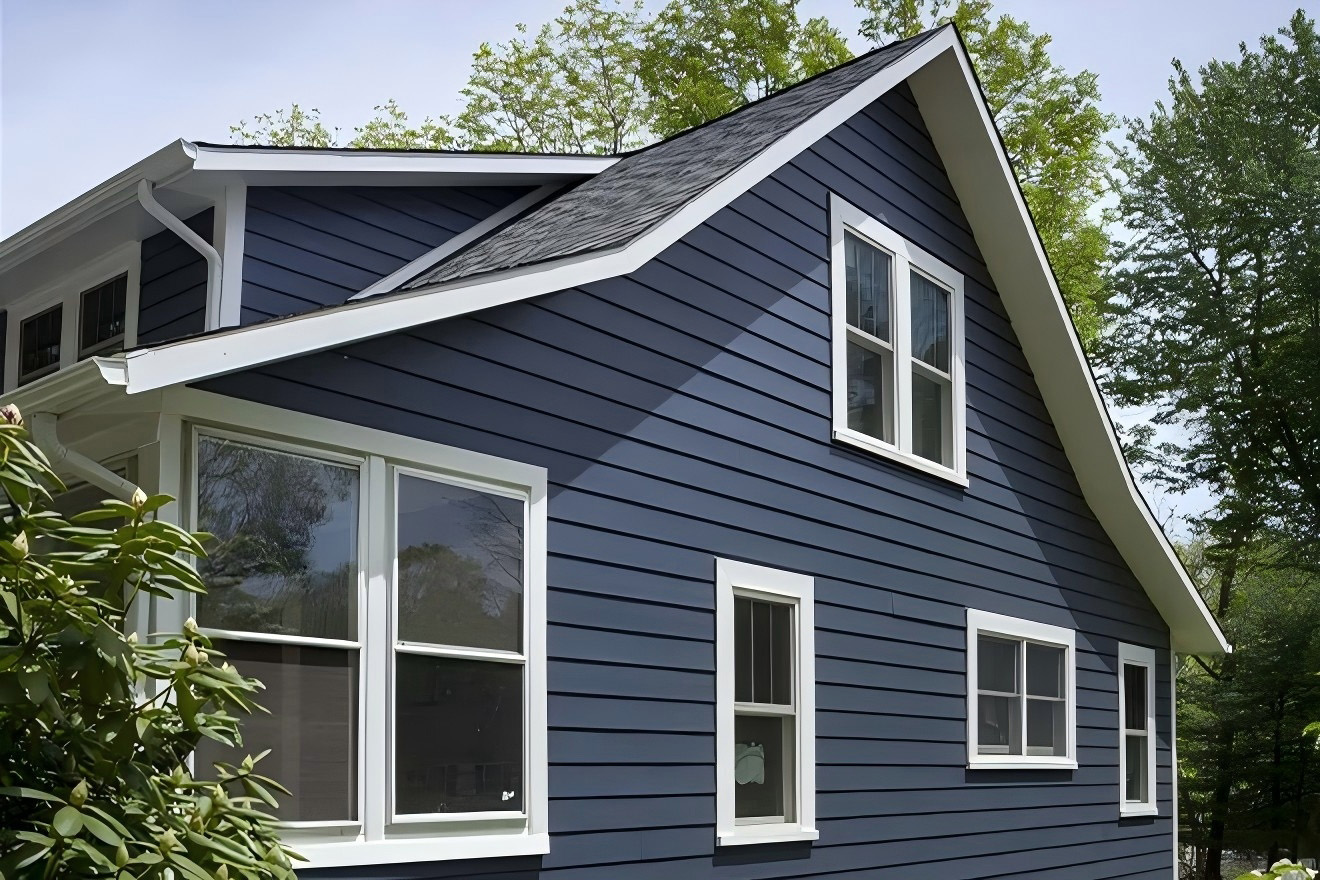When it comes to enhancing the exterior of your home, choosing the right siding is a decision that can significantly impact both its appearance and functionality. Two popular options on the market are aluminum siding and vinyl siding. Each has its own set of characteristics, advantages, and potential drawbacks. In this comprehensive guide, we'll delve into the details of these two siding materials to help you make an informed choice for your home.

Aluminum Siding Wall

Vinyl Siding Wall
What is Aluminum Siding?
Aluminum siding is a metal - based siding option that has been a fan - favorite in the siding industry for quite some time. It is known for its durability and resistance to a variety of elements. One of the key advantages of aluminum siding is its resistance to pests, water, mold, mildew, and changing temperatures. This makes it an excellent choice for homes in areas with extreme weather conditions.
In terms of appearance, aluminum siding can have a sleek, metallic, and modern look. However, some varieties are designed to mimic the appearance of real wood, providing homeowners with more aesthetic options. Additionally, aluminum siding can be painted, allowing you to customize its color to match your home's style and color scheme.
Pros of Aluminum Siding
Durability:
Aluminum siding is highly durable and can withstand harsh weather conditions, including strong winds, heavy rain, and extreme temperatures. It is resistant to fire, water, pests, rot, mold, scratches, and cracks, ensuring a long lifespan for your home's exterior.
Low - Maintenance:
With a smooth, metal surface, aluminum siding is easy to maintain. It doesn't require frequent repainting or laborious cleaning. A simple wash with water and soap is usually sufficient to keep it looking clean and presentable.
Economical:
Coming in at a relatively low cost of just $3 to $7.25 per square foot, aluminum siding is an affordable option for homeowners on a budget. Its long lifespan also means that you won't have to replace it frequently, saving you money in the long run.
Eco - Friendly:
Aluminum is a highly recyclable material. Choosing aluminum siding for your home contributes to environmental sustainability as the material can be reused again and again.
Easy Installation:
Aluminum siding is lightweight, which makes it easier to install compared to some other siding materials. This can potentially save you on installation costs as well.
What is Vinyl Siding?
Vinyl siding is made from plastic or polyvinyl chloride (PVC) resin and is designed to imitate the appearance of actual wood siding. It has gained popularity among homeowners due to its affordability and low - maintenance requirements. Vinyl siding comes in a wide range of colors and textures, allowing you to choose an option that complements your home's architecture and personal style.
Susceptibility to Dents:
Although aluminum is a strong material, it is still prone to denting. If you live in an area with frequent hail storms or where there is a risk of physical impact, such as from falling branches or sports equipment, aluminum siding may not be the best choice as it can easily get dented.
Appearance Limitations:
While aluminum siding can be painted, it may not entirely mimic the appearance of natural wood as convincingly as some other siding options, such as engineered wood siding. If you're aiming for a rustic or traditional wood - look for your home, aluminum siding might not meet your aesthetic expectations.
Salt Water Corrosion:
Aluminum siding is not suitable for homes located near the coast or in areas with high salt content in the air. Exposure to salt water can cause the aluminum to rust over time, compromising its integrity and appearance.
Noise in Extreme Weather:
Aluminum siding can produce pinging sounds during high winds or on hot days. This can be a nuisance for some homeowners, especially those who prefer a quiet exterior environment.
Pros of Vinyl Siding
Cost - Effective:
Vinyl siding is generally more affordable than many other siding options, both in terms of material cost and installation cost. This makes it an attractive choice for homeowners looking to update their home's exterior on a budget.
Low Maintenance:
One of the biggest advantages of vinyl siding is that it requires minimal maintenance. Since it is infused with color during the manufacturing process, there is no need to paint it. It is also resistant to pests and rot, reducing the need for frequent inspections and repairs.
Weather Resistance:
Vinyl siding is resistant to rust and corrosion, making it suitable for homes in various climates. It can withstand strong winds, heavy rain, and temperature fluctuations without significant damage.
Color and Style Options:
With a plethora of color and texture options available, vinyl siding allows you to achieve a customized look for your home. Whether you prefer a classic, traditional look or a more modern and contemporary style, there is likely a vinyl siding option that will meet your aesthetic preferences.
Moisture Resistance:
Vinyl siding does not absorb moisture, which helps prevent issues such as mold and mildew growth. This is particularly beneficial for homes in humid climates or areas with high rainfall.
Cons of Vinyl Siding
Susceptibility to Extreme Weather:
In extremely cold temperatures, vinyl siding can become brittle and more prone to cracking. On the other hand, in very hot temperatures, it may warp. This means that in regions with extreme temperature variations, vinyl siding may require more careful consideration.
Moisture Detection Issues:
While vinyl siding is moisture - resistant on the surface, if moisture does manage to get behind the siding, it can be difficult to detect. This hidden moisture can potentially lead to damage to the underlying structure of your home over time.
Environmental Concerns:
Vinyl is a plastic material, and its production and disposal can have environmental implications. Although some vinyl siding manufacturers are taking steps to improve the sustainability of their products, it is generally considered less eco - friendly compared to materials like aluminum.
Limited Lifespan:
While vinyl siding can last for a long time, it generally has a shorter lifespan compared to aluminum siding. With proper maintenance, it can last up to 20 - 40 years, but in some cases, it may need to be replaced sooner.
Aluminum Siding vs Vinyl Siding: A Head - to - Head Comparison
Cost
Aluminum siding typically has an average cost of around $11,750, while vinyl siding comes in slightly more expensive, with an average cost of approximately $12,200. However, both materials are considered budget - friendly options compared to some other siding alternatives, such as wood or fiber cement. The cost of installation can also vary depending on factors such as the complexity of the job, the region where you live, and the quality of the materials used.
Durability
Aluminum siding is highly durable and can withstand a wide range of weather conditions, pests, and other potential sources of damage. It has a long lifespan, often lasting up to 50 years or more with proper maintenance. Vinyl siding is also durable but may be more susceptible to damage in extreme weather conditions. In cold weather, it can become brittle, and in hot weather, it may warp. With normal use and maintenance, vinyl siding can last between 20 - 40 years.
Maintenance
Aluminum siding requires minimal maintenance. Occasional cleaning with water and soap is usually sufficient to keep it looking good. It may need to be repainted every 10 years or so to maintain its appearance. Vinyl siding is even lower - maintenance as it does not require painting. However, it should be inspected regularly for any signs of damage, such as cracks or warping, especially in areas with extreme weather.
Appearance
Aluminum siding can offer a modern, industrial look, although there are options available that mimic the appearance of wood. Vinyl siding is designed to imitate the look of real wood siding and comes in a wide variety of colors and textures, providing more options for achieving a natural - looking finish.
Energy Efficiency
Neither aluminum nor vinyl siding is known for its exceptional energy - efficiency on its own. However, both can be installed with additional insulation materials to improve the energy - efficiency of your home. Vinyl siding, in some cases,
may offer better insulation properties due to its cellular structure, but this can vary depending on the specific product and installation.
Environmental Impact
Aluminum is a highly recyclable material, making aluminum siding an eco - friendly choice. Vinyl, on the other hand, is a plastic material, and its production and disposal can have a greater environmental impact. However, some manufacturers are working on developing more sustainable vinyl siding options, such as those made from recycled materials.
Conclusion
In conclusion, both aluminum siding and vinyl siding have their own unique advantages and disadvantages. By carefully considering factors such as cost, durability, maintenance, appearance, energy efficiency, and environmental impact, you can make an informed decision that will enhance the beauty, functionality, and value of your home. Whether you choose the durability and modern look of aluminum siding or the cost - effectiveness and low - maintenance of vinyl siding, both options can provide a long - lasting and attractive exterior for your home. If you're still unsure which option is best for you, it may be helpful to consult with a professional siding contractor who can provide expert advice based on your specific situation.
English
العربية
Français
Русский
Español
Português
Deutsch
italiano
日本語
한국어
Nederlands
Tiếng Việt
ไทย
Polski
Türkçe
ភាសាខ្មែរ
Bahasa Melayu
Filipino
Bahasa Indonesia
magyar
Română
Čeština
Монгол
हिन्दी
فارسی
Slovenčina
Slovenščina
Norsk
Svenska
Ελληνικά
Suomi
Latine
Dansk
Shqip
Hrvatski
Afrikaans
Gaeilge
Eesti keel
latviešu
Azərbaycan dili
Беларуская мова
ქართული
íslenska
Kinyarwanda
Lietuvių
Lëtzebuergesch
Македонски
Malti
Türkmençe
ئۇيغۇرچە
Cymraeg












